Team performance is an important aspect of any project or business.
A team can be motivated or demotivated.
This is quite normal. As a team leader or manager, you must ensure that your team stays motivated. When demotivated, employ effective strategies to help them motivate.
If your team is underperforming, demotivated, or disoriented at any time, the book, “The Five Dysfunctions of a Team” by Patrick Lencioni is an awesome recommendation for you.
I will give you a summary of this great book for teams and review some of the principles discussed within the book.
The book dives into some of the most common challenges most teams face and strategies to curb them.
Have you asked yourself questions like;
What does a dysfunctional team look like?
How can you recover team morale?
How can you keep your team motivated?
This “Five Dysfunctions of a Team” book summary explains the book’s contents and teaches you about team management.
To begin with, who wrote the book, “Five Dysfunctions of a Team?”
The book, “Five Dysfunctions of a Team,” was written by Patrick Lencioni. Patrick Lencioni is an American author and has written several books and business.
About the Author: Patrick Lencioni
Who is the author of the book, “The Five Dysfunctions of a Team”?
Patrick Lencioni.
Who is Patrick Lencioni?
Patrick Lencioni is a speaker and business management consultant and has authored 11 books on business management.
“The Five Dysfunctions of a Team,” published in 2002, is considered his best work among many other books.
What other books on business & management has Patrick Lencioni published?
A few other popular books by Patrick Lencioni are:
- “The Five Temptations of a CEO: A Leadership Fable” is one of Patrick’s books and covers the main temptations of CEOs.
- “The Four Obsessions of an Extraordinary Executive: A Leadership Fable” is a business book that focuses on an executive entrepreneur or executive. In it, Patrick describes how to achieve optimum organizational health in companies and teams.
- “Death by Meeting: A Leadership Fable” – In this business book, Patrick highlights that businesses may engage in unproductive meetings. The book “Death by Meeting” shares some methodologies for solving the problem of unproductive meetings.
- “Overcoming The Five Dysfunctions of a Team: A Field Guide for Leaders, Managers, and Facilitators”
You can say Patrick’s business knowledge is outstanding. He is proven to be one of the best business and team management scholars in the world.
He is the founder and president of the Table Group, a management consulting firm that specializes in executive team development and organizational health improvement.
Patrick Lencioni was also a VP of Organization Development at Sybase.
Patrick Lencioni’s professional accomplishments?
Patrick’s writing is backed by many years of expertise earned from real-life experiences. He was a management consultant in many well-known organizations, such as Bain & Company and Oracle Corporation.
As a consultant and keynote speaker, Patrick has worked with executives from Fortune 500 companies, high-tech start-ups, and prestigious universities.
He gives presentations on leadership, organizational change, teamwork, and corporate culture. In 2008, CNN Money mentioned him in their “10 New Gurus You Should Know” article.
He was also named “One of the Most In-Demand Business Speakers” by The Wall Street Journal.
Now we know a little about the author of “The Five Dysfunctions of a Team,” let’s dive into what the book covers in summary.
Business Book Review: “The Five Dysfunctions of a Team.”
What Are The Five Dysfunctions of a Team?
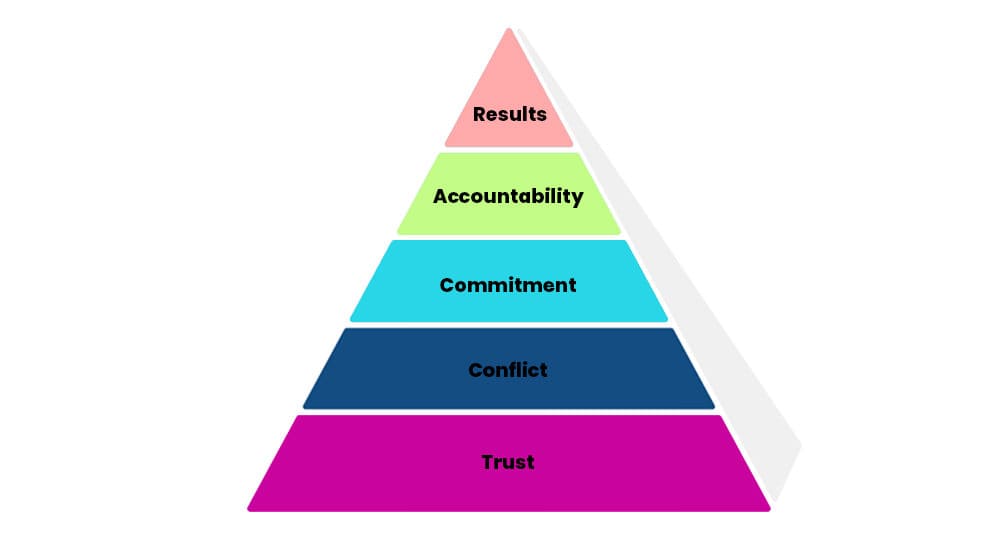
The above pyramid shows the five dysfunctions of a team discussed in the book.
Patrick Lencioni is a popular business management expert. His most popular work is The Five Dysfunctions of a Team.
Patrick believes every team is liable to dysfunction. The five dysfunctions discussed in the book are now a guide to healthy teams.
It is packed with practical information to help build a healthy team.
To ensure this is easy to understand, Patrick Lencioni broke these team dysfunctions into five (5).
These 5 dysfunctions by Patrick Lencioni in the book, “The Five Dysfunctions of a Team” are:
- Dysfunction #1: Absence of Trust
- Dysfunction #2: Fear of Conflict
- Dysfunction #3: Lack of Commitment
- Dysfunction #4: Avoidance of Accountability
- Dysfunction #5: Inattention to Results
To explain these dysfunctions, Patrick created a leadership fable of a tech company that wants to grow its customers but cannot do so because of an inefficient team.
When Catherine Peterson, the new CEO, joins the organization, she identifies the issues preventing the team from achieving its objectives.
Let’s dive into these five dysfunctions and understand them better.
Dysfunction #1: Absence of Trust
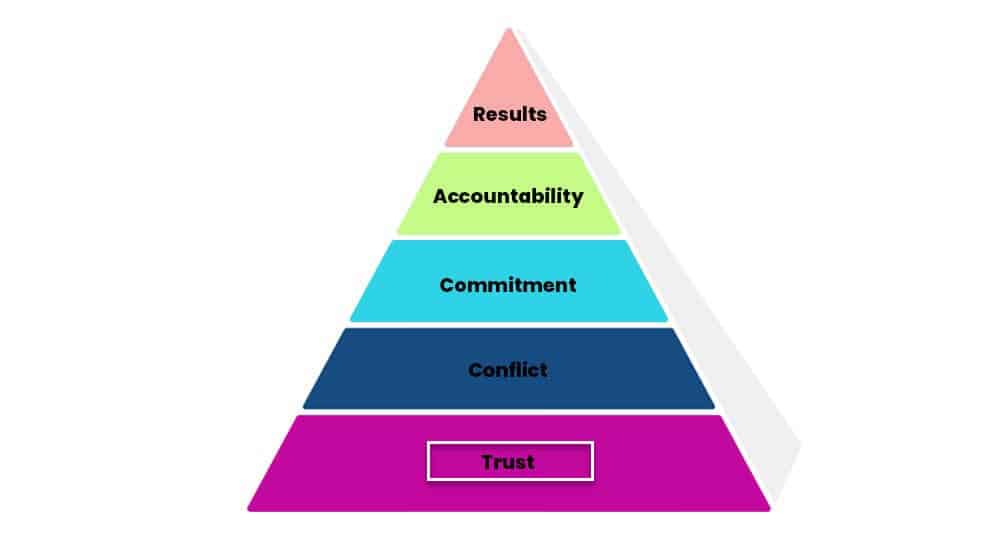
What is the first dysfunction discussed in “The 5 Dysfunctions of a Team?”
The absence of trust is the first dysfunction.
Patrick Lencioni explains how the absence of trust among the team is the key reason for poor performance.
In this team management book, Patrick states that team survival is extremely difficult when team members are hesitant and unwilling to share their weaknesses and vulnerabilities.
They may not open due to lack of trust. This team considers other team members adversaries who can betray them.
A bonded team openly shows its limitations or lack of knowledge on a subject because it knows that no one will judge it and that its weaknesses will not be used against it.
They let go of their fears and shame and became comfortable with each other. They share their knowledge or ideas and work as a team to the best of their ability.
This collaboration won’t be possible if you don’t know your colleagues and don’t care enough to leave a positive impression on them.
Without trust, it becomes difficult to survive and grow in a business environment.
It becomes a closed-end and insufferable environment where people spend most of their time. They will spend energy hiding mistakes instead of focusing on the work.
Why is trust important in teams?
A team that does not trust each other and collaborate—is destined to fail.
By calling out the dysfunction, Patrick explains that distrust in the team is very common.
As people get defensive and competitive. Patrick says expecting a broken team to start trusting each other overnight is impossible and illogical. The change takes time.
How to Solve an Absence of Trust in a Team
How do you build trust among team members?
Patrick Lencioni has some strategies that are known to work.
According to the author, certain techniques and team management approaches can help resolve trust issues within any team.
Some of these are:
Know Your Colleagues
We spend more time with our colleagues than our friends or distant family members.
The irony is that we don’t know much about the people working beside us!
Patrick suggests team-building exercises. During group meetings, teams can have small sessions to familiarize themselves with each other on a personal level (not just work-related)
These team exercises help create a stronger bond between team members.
Develop Routine Team Building Activities
You can have team-building activities to help team members bond with each other.
For example, you can ask team members to explain funny moments to other members.
Don’t insult or humiliate others – this breaks teams rather than builds.
Ensure these team exercises are respectable and humorous. This will allow team members to enjoy being part of your team.
Dysfunction #2: Fear of Conflict
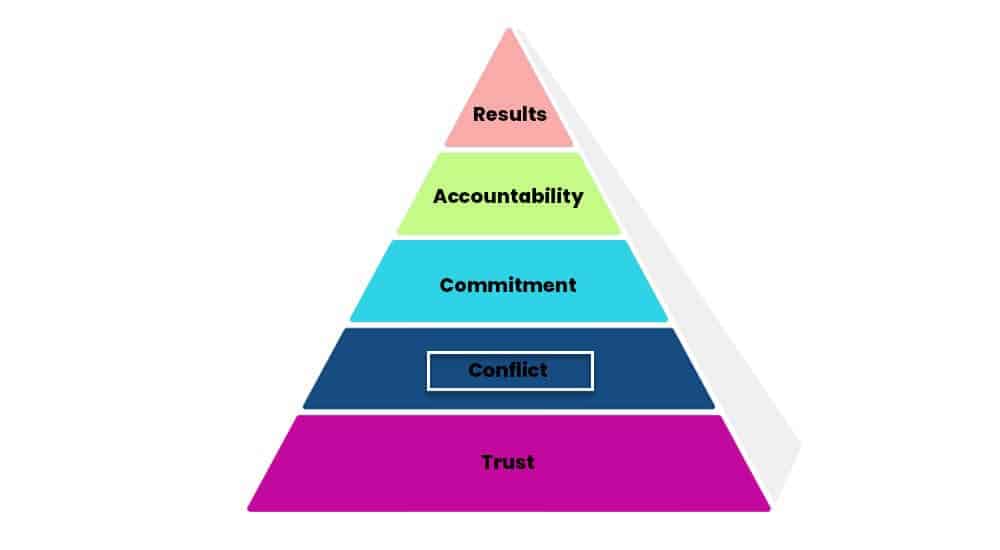
What is the second dysfunction discussed in “The Dysfunctions of a Team”?
Fear of conflict!
Patrick Lencioni believes conflicts are good and needed for effective team growth. According to Patrick, conflicts strengthen teams.
Conflicts in a team can be a sign that a relationship is starting to grow. Conflicts are not always negative.
They can be constructive if they are not personal, aggressive, or revengeful.
An ideological conflict can help grow a team.
Patrick says that teams have artificial harmony. To maintain this harmony, team members often refrain from voicing their opinions—especially if they differ from their teammates.
The downside is that they avoid discussions or debates that could bring innovative solutions or ideas.
This approach is detrimental to team and organizational growth.
How to Solve a Fear of Conflicts in a Team
How do you solve the fear of conflicts within a team?
In the book “The Dysfunctions of a Team,” Patrick shares some of the most effective ways to resolve the fear of team conflicts.
Some of these are:
Encourage Openness
How do you encourage openness in a team?
Team members must speak their minds about a problem and provide a solution.
Their ideas should be respected and listened to as long as they are not disrespectful and logical.
This will be difficult at first, but better solutions will emerge once the discussion of disagreement starts.
Control the Discussion
A debate or disagreement can sometimes get uncomfortable, and you may want to end it immediately.
You must step in and remind everyone to contribute positively when the conversation goes in that direction.
Dysfunction #3: Lack of Commitment
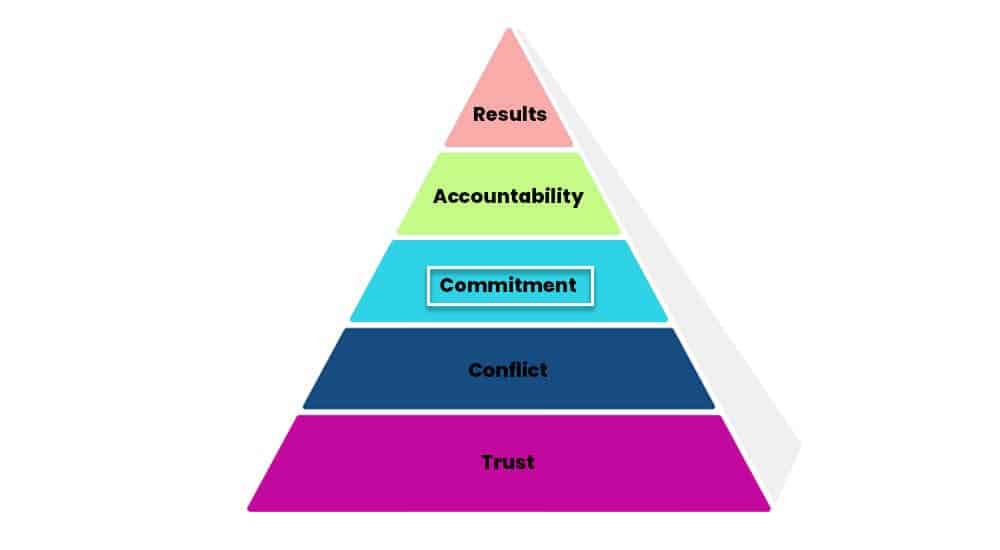
What are the third dysfunctions of a team discussed in “The Dysfunctions of a Team?”
The third dysfunction of a team is Commitment.
Commitment is the key to team success. However, getting a team to commit is difficult when they disagree on every decision.
If there is disagreement between team members, there won’t be commitment—even if they pretend to be committed. They will do things without cohesion, and the outcome will be a failure.
The author of this business and team management book indicates two major hurdles to team commitment:
- Consensus and;
- Certainty.
Try making the team feel like their ideas are always heard. This will help you achieve a consensus. Do not try to convince all team members; rather, appreciate their ideas and try to include them in the plan.
To achieve certainty, communicate the importance of making a decision that can later be changed or modified rather than not making any decision at all.
How to Solve a Lack of Commitment in a Team
How can you resolve lack of commitment in a team according to Patrick Lencioni’s “The Five Dysfunctions of a Team”?
The following can help solve lack of commitment issues in a team:
Communicate the Summary
Always communicate your decisions to team members.
Often, team members who are not involved in the decision-making process receive incomplete information and are not aware of the deliverables and the seriousness of the issues.
To fix this, share a decision summary.
Set a Deadline
Setting deadlines can help teams work more efficiently. It’s been proven to increase worth-ethic and boost productivity.
Setting a deadline helps you know which team member is committing to which goal.
Setting deadlines has always been helpful in timely job fulfillment.
Make a Contingency Plan
You must design a contingency plan at all times.
You can create a contingency plan and share it with your teams to test a solution that may not work. When things do not work out as planned, you will implement the contingency plan.
This team management book by Patrick helps you create a contingency plan for your brand.
Dysfunction #4: Avoidance of Accountability
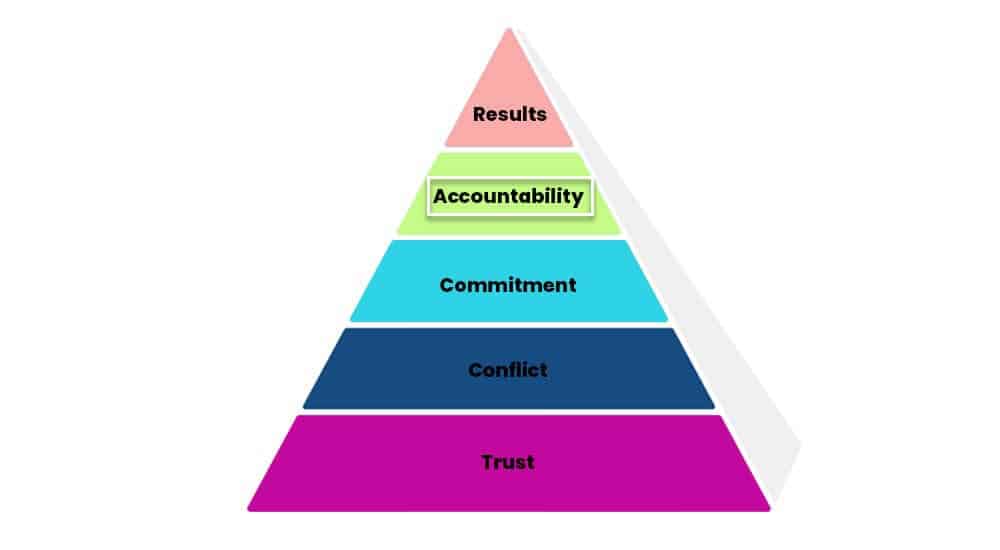
What is the next dysfunction of a team?
Avoidance of accountability.
Often, team members hesitate to discuss issues related to their behavior and performance. It is a difficult but necessary conversation.
Patrick encourages raising performance-related issues and addressing unacceptable behavior or attitudes toward peers.
Often, team members avoid calling out the person to avoid being the bad guy and ruining their relationship.
As a result, work affects. You must hold people accountable for their responsibilities.
If you address the issues early, your peers will amend their actions, and the work environment will improve.
How to Solve an Avoidance of Accountability in a Team
How do teams resolve the issue of accountability?
Patrick Lencioni shares some expert insights in this very team management book.
The following can help solve accountability issues in the team:
Assign Personal Goals
You should always assign personal goals to team members.
The author, Patrick Lencioni, suggests setting individual goals and making team members aware of them.
Why is it important to set personal goals for team members?
Assigning personal goals specifies who is responsible for what, what work is expected from them, and when (deadline).
It also removes the guesswork and holds employees accountable for their performances.
Review Peers’ Work
The author also encourages an internal routine progress review of each other’s work. They can check their colleagues’ tasks and share their feedback. Having someone else check your work is always better than doing it alone.
Give Collective Rewards
How do you give collective rewards?
The author, Patrick, suggests that a leader should always reward a team instead of individual promotion.
All team members contribute to the achievement, so everyone should feel involved, held accountable for their mistakes, and appreciated. This creates an accountability culture in every team.
Dysfunction #5: Inattention to Results
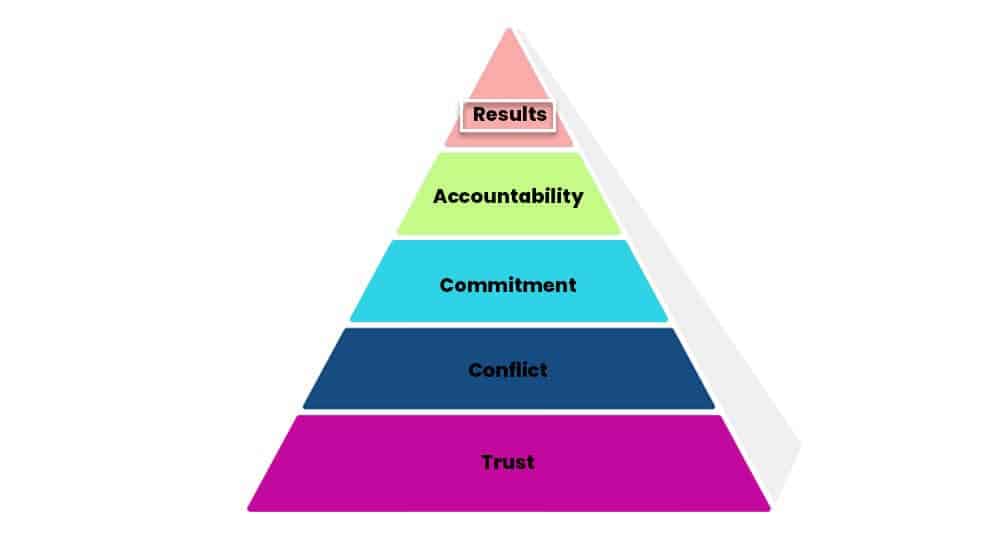
What is the fifth and final dysfunction of a team, according to the book, “The Five Dysfunctions of a Team?”
Inattention to results!
Inattention to results means attention is given to something else.
Patrick Lencioni points out the issue of focusing on personal fulfillment instead of team objectives.
Performance suffers when team members care more about their benefit than the team goal.
Often, team members are satisfied to be part of a group, which is enough for them.
This is called team status. If team members are self-centered, team growth is affected.
According to Patrick, the most important aspect of any team is meeting the end goal. If this is not met, the team has lost its meaning.
The focus should be on results with no distractions.
How to Solve an Inattention to Results in a Team
How do you resolve inattention to results in a team according to “The Five Dysfunctions of a Team”?
Patrick Lencioni, the author of the team management book, suggests two effective ways to address team inattention to results.
Make a Public Declaration of Results
Patrick suggests publicly declaring the results.
This will put the team in the spotlight, motivate them to perform better, and avoid embarrassment. The team will be on top of its game and shift its focus to the results.
Give Results-Based Rewards
Patrick suggests attaching financial rewards to results. Ideally, this shouldn’t be the only element that interests the team in the goal, but it has always been effective in achieving the desired results.
Finally, the Summary of The Five Dysfunctions of a Team” by Patrick Lencioni
If you are thinking about reading this book but are still unsure, I highly recommend you do so, especially if you run or lead a team.
Poor team performance, low employee morale, and conflicts are common dysfunctions within business teams. In this team management book, Patrick Lencioni shares some of the causes of these dysfunctions and details strategies to reduce and manage these dysfunctions.
This book on team dysfunction effectively covers the issues hindering team performance, and you should refer to it to learn how to change a dysfunctional team into a functional one.
What do you think about this team management book review?
I hope you gained some insights from this summary of Patrick Lencioni’s best-selling book, “The Five Dysfunctions of a Team.”
Top Lessons I Learned From the Book, “The Five Dysfunctions of a Team” by Patrick Lensioni.
What are some top lessons I learned from this team management book?
These are the top 5 lessons I learned from reading “The Five Dysfunctions of a Team” by Patrick Lencioni:
- Trust is built in the long run. You have to be consistent and diligent. Building your team’s trust is crucial for both business and personal goals.
- One important thing I have learned and will definitely put into practice is to embrace conflict. Not just any conflict but positive conflicts that open the way for growth. So rather than avoid conflicts, embrace them as a way to grow. According to Patrick Lencioni, conflicts are a sign that team members are getting along.
- Commitment is key to growth. If a team is not committed to achieving a specific goal, there’s less room for growth.
- To keep track of your team, accountability should be a priority. Hold your team accountable at all times.
- Finally, pay more attention to results. Pay attention to the return on investment your team makes.
FAQ Around the Team Management Book, “The Five Dysfunctions of a Team.”
Q1: Who created the Lencioni model?
The Lencioni model is a business and team management principle that follows the 5 characteristics of any team. This team management principle was first introduced by Patrick Lencioni (hence, Lencioni Model) in his book, “The Five Dysfunctions of a Team.”
Q2: What are the principles of Lencioni?
The principles of Lencioni, which is also called the Lencioni Model, is a team management principle that follows the 5 ideologies of any cohesive team. These principles discussed in the book “The Five Dysfunctions of a Team” are;
- absence of trust,
- fear of conflict,
- lack of commitment,
- avoidance of accountability, and;
- inattention to results.
Q3: What causes a team to be dysfunctional?
In his team management book, Patrick discussed some of the principles in every team. These are dysfunctions that happen in every team. Some of the most common causes for a dysfunctional team are lack of trust between members, fear of conflict, poor communication, lack of team cohesion, and more.
Q4: How do you fix a dysfunctional group?
There is no one direct way to automatically fix a dysfunctional team or group. To fix a dysfunctional group or team, you must first identify the cause of the team’s dysfunctions. According to The Five Dysfunctions of a Team, the main causes are lack of trust, conflict, lack of commitment, lack of accountability, and inattention to results.
After this, you can approach the cause head-on. Patrick shares actionable insights that help you fix a dysfunctional team in the book.
Q5: How do you build trust in a dysfunctional team?
The best way to build trust is to earn it, just like the popular saying, “trust is earned.” Patrick, in his team management book, discusses some of the best ways to build trust within a team. Building trust takes time and requires a plan. Organize daily or weekly team activities that allow employees to bond and connect more personally.
Q6: How many pages are the five dysfunctions of a team?
The book “The Five Dysfunctions of a Team” by Patrick Lencioni was published in English and has 229 pages.
Q7: How many books has Patrick Lencioni written?
Patrick Lencioni has written several books on business and team management.
Some of these are:
- The Five Temptations of a CEO: A Leadership Fable.
- The Four Obsessions of an Extraordinary Executive: A Leadership Fable.
- Death by Meeting: A Leadership Fable.
- Overcoming The Five Dysfunctions of a Team: A Field Guide for Leaders, Managers, and Facilitators.
Q8: Can you download the Five Dysfunctions of a Team PDF for Free?
No. You cannot download the soft copy of this book for free. You must buy this book from Amazon or any other store.

I am Mohammad Fahad Usmani, B.E. PMP, PMI-RMP. I have been blogging on project management topics since 2011. To date, thousands of professionals have passed the PMP exam using my resources.






